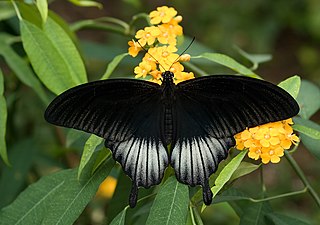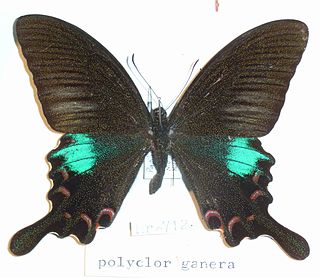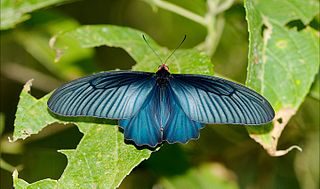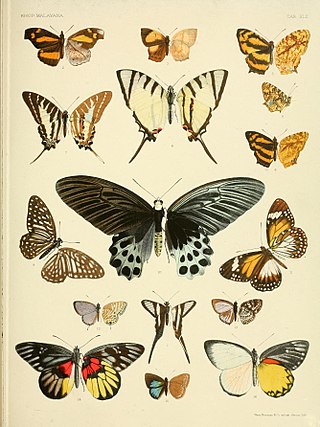
Papilio memnon, the great Mormon, is a large butterfly native to southern Asia that belongs to the swallowtail family. It is widely distributed and has thirteen subspecies. The female is polymorphic and with mimetic forms.

Papilio paris, the Paris peacock swallowtail, is a species of swallowtail butterfly found in the Indian subcontinent and southeast Asia.

Papilio bootes, the tailed redbreast, is a swallowtail butterfly found in Asia. Within their wide distribution about four population variants have been named as subspecies. They have been placed within the Menelaides clade by a 2015 phylogenetics study.

Papilio nephelus is a species of swallowtail butterfly belonging to the family Papilionidae. Subspecies include P. n. chaon, the yellow Helen, and P. n. sunatus, the black and white Helen.

Papilio polyctor, the common peacock or indian peacock or mahaonovaya indian butterfly with emerald- is a swallowtail butterfly found in the Indian subcontinent. It is found in the Himalayas and parts of India from the foothills to 7,000 feet (2,100 m) between March and October. It has distinct dry- and wet-season forms. The butterfly frequents Buddleia flowers. Its food plant is Zanthoxylum alatum of the family Rutaceae. Papilio polyctor has three subspecies, consisting of Papilio polyctor significans, Papilio polyctor stockleyi, and Papilio polyctor xiei.

Losaria coon, the common clubtail, is a butterfly belonging to the swallowtail family, Papilionidae. The butterfly belongs to the clubtails, genus Losaria. It includes several subspecies and is found from the Nicobar Islands and Assam in India, east to Hainan in China, and south through Indochina, to Java and other islands of Indonesia and Bangladesh.

Papilio clytia, the common mime, is a swallowtail butterfly found in south and southeast Asia. The butterfly belongs to the subgenus Chilasa, the black-bodied swallowtails. It serves as an excellent example of a Batesian mimic among the Indian butterflies.

Papilio (Chilasa) epycides, the lesser mime, is a swallowtail butterfly found in India and parts of South-East Asia. The butterfly belongs to the mime (Chilasa) subgenus or the black-bodied swallowtails. It is a mimic of a common Indian Danainae, the glassy tiger butterfly.

Papilio (Chilasa) paradoxa, the great blue mime, is a swallowtail butterfly found in India and parts of South-East Asia. The butterfly belongs to the mime subgenus, Chilasa, of the genus Papilio. It is an excellent mimic of different species of Euploea.

Papilio mayo, the Andaman Mormon, is a species of swallowtail butterfly that is endemic to the Andamans in the Bay of Bengal. It is a species that is protected by Indian Law. The scientific name honours Richard Bourke, 6th Earl of Mayo, who was assassinated at Port Blair the year before the butterfly was discovered.

Atrophaneura aidoneus, the lesser batwing, is an Asian species of butterfly that belongs to the batwings group of Atrophaneura, comprising tailless black swallowtail butterflies.

Atrophaneura varuna, the common batwing, is a butterfly found in India and Southeast Asia that belongs to the swallowtail family, and more specifically, the batwings group of Atrophaneura, comprising tailless black swallowtail butterflies.

Papilio neumoegeni is a species of butterfly in the family Papilionidae. It is endemic to the islands of Sumba in Indonesia.

Papilio mechowi is a butterfly of the family Papilionidae found in Africa.

Papilio androgeus, the Androgeus swallowtail, queen page, or queen swallowtail, is a Neotropical butterfly of the family Papilionidae. It is found from Mexico to Argentina with a small population in southern Florida.

Papilio zagreus is a butterfly of the family Papilionidae (swallowtails). It is found in South America, including Venezuela, Colombia, Ecuador, Peru, Bolivia and western Brazil.

Papilio iswara, the great Helen, is a species of large swallowtail butterfly found in parts of Southeast Asia.

Atrophaneura sycorax is a species of butterfly from the family Papilionidae that is found from southern Burma to Peninsular Malaysia, and in Sumatra and western Java.

Mimoides pausanias, the Pausanias swallowtail or bluish mimic-swallowtail, is a species of butterfly in the family Papilionidae.



















